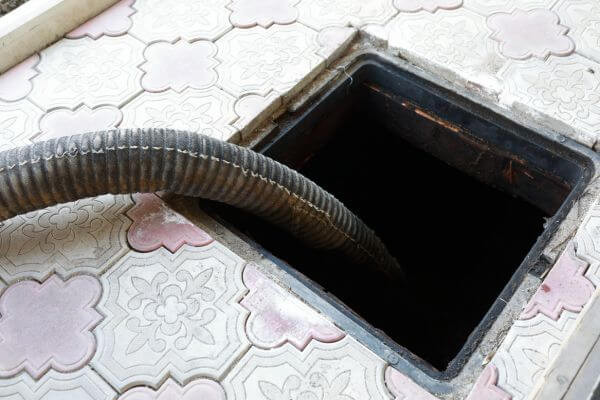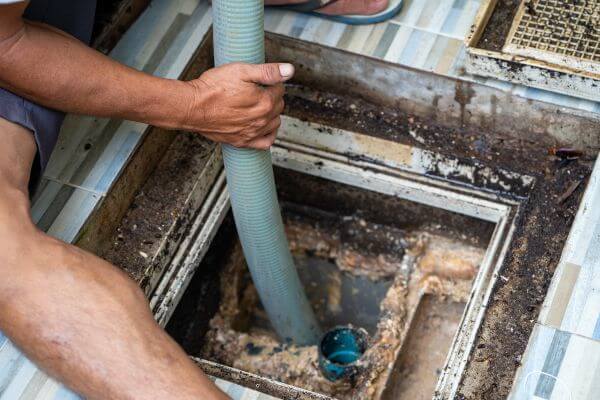Septic tanks are essential for wastewater management in many properties, especially in rural areas or dwellings far from sewerage networks. However, over time, these pits can become filled with solids and sludge which, if not removed, can cause problems with clogging, odours and pollution. In this post, we will show you how to clean a septic tank efficiently and safely.
Why is it important to keep a septic tank clean?
Cleaning a septic tank is crucial to ensure that it functions properly over the long term. Septic tanks are designed to process wastewater, allowing solids to settle to the bottom while liquids percolate into the surrounding soil. Without regular cleaning, solids build up, which can clog the system and lead to overflows or even drainage failures.
In addition, a septic tank that is not cleaned regularly can have a negative impact on the environment, contaminating groundwater or nearby water. Keeping the septic tank in good condition not only ensures its functionality, but also protects the health of people and the environment.
How often should a septic tank be cleaned?
The frequency of cleaning depends on the size of the pit and the use to which it is put. Generally, it is recommended to clean the pit every 3 to 5 years, but this may vary depending on the number of people living in the property, the type of waste being dumped into the pit, and the capacity of the pit. If the system is used intensively, it may need more frequent cleaning.
A clear indicator that the septic tank needs to be cleaned is the appearance of bad odours in the drainage area or slow drainage in the household drains. If you notice any of these symptoms, it is best not to wait any longer and proceed with the cleaning.

How do you know if your septic tank needs cleaning?
There are several signs that a septic tank is full or in need of maintenance:
- Bad smells: Decomposing odours near the pit or in the drainage areas are clear signs that something is not working properly.
- Slow drainage: If toilets, sinks or drains in the house are draining slowly, it may be an indication that the cesspit is overflowing.
- Puddles in the soil: The presence of puddles or abnormally wet areas in the garden or drainage area is a sign that liquids are no longer being absorbed properly by the soil.
- Gurgling sounds: If you hear bubbling or gurgling sounds in the drains when using water, the system may be clogged.
If you notice any of these signs, it is best to contact a specialist septic tank service.
How do you clean a septic tank?
Cleaning a septic tank is not something to be taken lightly. Although some people may choose to do it on their own, it is always advisable to call in professionals. The process of cleaning a septic tank follows several basic steps to ensure that the system is completely free of waste.
Step 1: Inspection of the pit
Before proceeding with the cleaning, it is important to carry out an inspection to assess the level of solids and to determine whether the pit really needs to be emptied. A professional can do this using specialised tools that measure the level of sludge and floating solids.
Step 2: Sludge and solids removal
Once it is determined that the pit needs cleaning, the solids accumulated at the bottom are removed. For this, a truck with a specialised suction system is used. This equipment sucks up the sludge and solids and transports them to a safe place for proper disposal.
During this process, care is taken not to damage the filtration system and pit components. This is one of the main reasons why it is essential to have professionals who know the system and have the necessary experience.
If you need this type of service, at Limpiezas Domingo we are specialists in the extraction and cleaning of septic tanks, offering efficient and hassle-free work.
Step 3: Washing and maintenance
Once the sludge has been removed, it is advisable to flush the inside walls of the pit with pressurised water. This helps to remove any residue that may have adhered and ensures that the pit is completely clean.
In some cases, it may also be necessary to check the drainage system to ensure that it is not clogged and is functioning properly. If any problems are detected in this process, the technician may suggest additional repairs.
Is it dangerous to clean a septic tank without the help of professionals?
Yes, cleaning a septic tank without the help of professionals can be dangerous. Septic tanks contain toxic gases, such as methane and hydrogen sulphide, which can be deadly if inhaled in high concentrations. In addition, the handling of sludge and sewage can pose a health risk if proper precautions are not taken.
For this reason, it is highly recommended that any septic tank cleaning is carried out by trained professionals equipped with the appropriate protective equipment. They have the necessary tools to carry out the work safely and efficiently, minimising any risk to health and the environment.
Tips for good septic tank maintenance
Although regular cleaning is essential, there are certain actions you can take to prolong the life of your septic tank and reduce the frequency of cleaning:
- Avoid pouring in harsh chemicals: Excessive use of cleaners and other household chemicals can kill the bacteria that break down the waste in the pit.
- Do not pour grease or oil: These materials can solidify and clog the system, making it difficult for liquids to filter properly.
- Spread out water use: Try not to overload the system by using too much water at once. It is advisable to space out activities that require large amounts of water, such as washing clothes or long showers.


Recent Comments